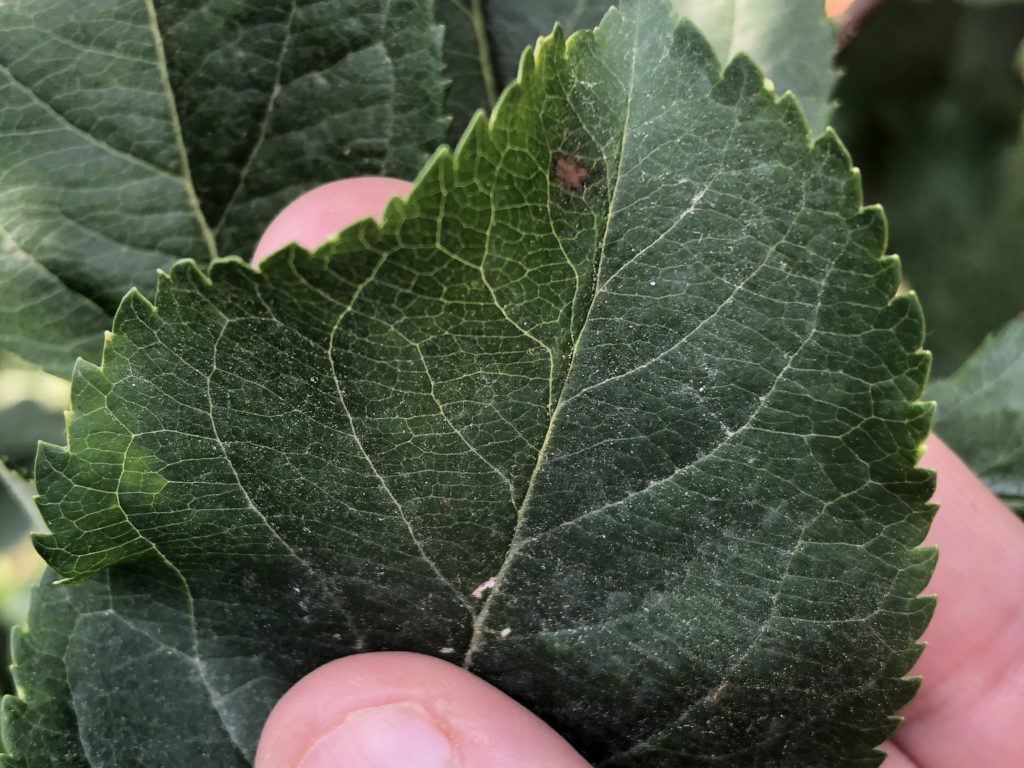Apple Disease Update: Week of June 2, 2019
go.ncsu.edu/readext?606030
en Español / em Português
El inglés es el idioma de control de esta página. En la medida en que haya algún conflicto entre la traducción al inglés y la traducción, el inglés prevalece.
Al hacer clic en el enlace de traducción se activa un servicio de traducción gratuito para convertir la página al español. Al igual que con cualquier traducción por Internet, la conversión no es sensible al contexto y puede que no traduzca el texto en su significado original. NC State Extension no garantiza la exactitud del texto traducido. Por favor, tenga en cuenta que algunas aplicaciones y/o servicios pueden no funcionar como se espera cuando se traducen.
Português
Inglês é o idioma de controle desta página. Na medida que haja algum conflito entre o texto original em Inglês e a tradução, o Inglês prevalece.
Ao clicar no link de tradução, um serviço gratuito de tradução será ativado para converter a página para o Português. Como em qualquer tradução pela internet, a conversão não é sensivel ao contexto e pode não ocorrer a tradução para o significado orginal. O serviço de Extensão da Carolina do Norte (NC State Extension) não garante a exatidão do texto traduzido. Por favor, observe que algumas funções ou serviços podem não funcionar como esperado após a tradução.
English
English is the controlling language of this page. To the extent there is any conflict between the English text and the translation, English controls.
Clicking on the translation link activates a free translation service to convert the page to Spanish. As with any Internet translation, the conversion is not context-sensitive and may not translate the text to its original meaning. NC State Extension does not guarantee the accuracy of the translated text. Please note that some applications and/or services may not function as expected when translated.
Collapse ▲ The theme of this week’s post is to PRACTICE PROTECTION! According to my weather apps, a fair amount of rain is predicted in Western NC beginning Wednesday afternoon and continuing through Friday. If you have not applied a fungicide in the past 10 days, make sure PROTECT foliage and fruit prior to the rain. If it rains more than 1.5″ (which is predicted), you should consider having a working weekend, and reapply if ONLY captan or another contact fungicide was used. If Merivon, Pristine, Flint, Luna Sensation, or another locally systemic fungicide was applied recently (within past 7 to ten days) you should be able to continue on that schedule due to the physical mode of action of these products.
The theme of this week’s post is to PRACTICE PROTECTION! According to my weather apps, a fair amount of rain is predicted in Western NC beginning Wednesday afternoon and continuing through Friday. If you have not applied a fungicide in the past 10 days, make sure PROTECT foliage and fruit prior to the rain. If it rains more than 1.5″ (which is predicted), you should consider having a working weekend, and reapply if ONLY captan or another contact fungicide was used. If Merivon, Pristine, Flint, Luna Sensation, or another locally systemic fungicide was applied recently (within past 7 to ten days) you should be able to continue on that schedule due to the physical mode of action of these products.
There are a few reasons why it would be advantageous for a fungicide application prior to the onset of the rain. First, fungi (and bacteria) love humid, wet conditions. Rain assists in pathogen dispersal, and usually reduces the required time for pathogen infection to occur and symptoms to show up. Secondly, during mid-cover applications, captan is primarily utilized for management of rot diseases such as bitter rot, as well as for Glomerella leaf spot. This fungicide is strictly protective, and thus must be applied before an infection event (e.g. the next few days) occurs. Lastly, we don’t have any efficacious fungicides registered on apples that will provide more than 24 hours kick-back activity against pathogens causing GLS/bitter rot. Strobilurins may provide 24-48 hours curative activity, but they provide much greater control when applied protectively.
As for what fungicides to apply? This might be a good time to apply a strobilurin as it has a longer breakdown-period and should continue to provide control, even after the rain. Make sure the product is applied prior to the rain and has time to dry, and tank mix with captan for resistance management. Captan plus a phosphorous acid can also be used prior to the rain, however, you may need to hop back on the tractor again on Saturday or Sunday.
Other Observations of Interest
- I’ve had a few reports about apple scab outbreaks throughout the region. Continue to monitor for scab lesions on leaves and fruit (see above). Fungicides being applied for GLS and bitter rot should continue to provide control against this disease.
- Despite the relatively dry May, I’m continuing to receive reports of Glomerella leaf spot (see image of developing lesion below). As noted in the previous post-do not let the lack of rain fool you. It’s been humid, hot, and there has been a considerable amount of leaf wetting hours throughout the past month (dew on leaves). Continue to PROTECT every 7 to 10 days, especially for apples headed to the fresh market.

- In young, non-bearing orchards, protect trees with a low rate (e.g. not the green-tip rate) of a fixed copper. Monitor for phytotoxicity to leaves.


